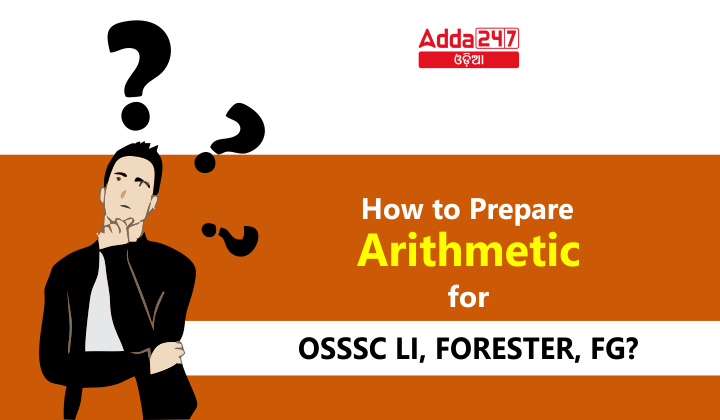Competitive exams such as those conducted by the Odisha Sub-ordinate Staff Selection Commission (OSSSC) for positions like LSI (Livestock Inspector), Forester, and Forest Guard often include a significant portion dedicated to Arithmetic. To excel in these exams, it is crucial to have a solid understanding of various arithmetic topics. Let’s delve into some key arithmetic topics and work through examples to enhance your preparation.
Understanding OSSSC LSI, Forester, FG Arithmetic Syllabus
- Understanding the exam syllabus for the Arithmetic language component in the OSSSC LSI, Forester, FG Recruitment is essential to plan your preparation effectively.
- Begin by thoroughly understanding the Arithmetic syllabus for the recruitment exam. This will help you identify the specific topics and areas you need to focus on.
- Here’s a breakdown of the key topics typically included in the syllabus:
| Subject | Topic |
| Arithmetic |
|
Understanding OSSSC LSI, Forester, FG Arithmetic Exam Pattern
- The written test for LSI, Forester, FG consists of objective-type multiple-choice questions only.
- This exam has negative marking, with a penalty of 0.25 marks for each wrong answer in the written test.
- OSSSC LSI, Forester, and Forest Guard Exam Pattern 2023: The OSSSC LSI, Forester, and Forest Guard written exam will consist of multiple choice questions.
- The total duration of the written test will be 2 1/2 hours and the maximum marks will be 150.
| Post Name | Full Marks | No. Of Questions | No. Of Questions in Arithmetic |
| LSI, Forester, FG | 150 | 150 | 25 |
General Tips:
- Maintain a consistent study schedule.
- Stay disciplined and avoid procrastination.
- Take short breaks during study sessions to stay refreshed.
- Keep a positive attitude and stay confident in your abilities.
1. Simple Interest:
Question 1: If the principal is Rs. 2000, the rate of interest is 4% per annum, and the time is 3 years, what is the simple interest?
A. Rs. 240
B. Rs. 250
C. Rs. 260
D. Rs. 270
Solution 1:
Correct Answer: A. Rs. 240
The formula for calculating Simple Interest (SI) is:
where:
Given the values:
- Principal () = Rs. 2000,
- Rate of Interest () = 4% per annum,
- Time () = 3 years.
Substitute these values into the formula:
Calculate the result: =(2000×4×3)/100
Therefore, the Simple Interest (SI) on a principal of Rs. 2000 at a rate of 4% per annum for 3 years is Rs. 240.
Question 2: A sum of Rs. 3000 is invested at an interest rate of 6% per annum. Find the simple interest after 2 years.
A. Rs. 300
B. Rs. 330
C. Rs. 360
D. Rs. 380
Solution 2:
Correct Answer: C. Rs. 360
2. Compound Interest:
Question 3: Calculate the compound interest on Rs. 5000 at an annual rate of 8%, compounded annually for 2 years.
A. Rs. 820
B. Rs. 840
C. Rs. 860
D. Rs. 880
Solution 3:
Correct Answer: B. Rs. 840
Question 4: If the compound interest on a sum of money is Rs. 1200 at an annual rate of 10%, find the principal amount. The interest is compounded annually for 3 years.
A. Rs. 3000
B. Rs. 4000
C. Rs. 5000
D. Rs. 6000
Solution 4:
Correct Answer: A. Rs. 3000
3. Ratio and Proportion:
Question 5: If the ratio of the lengths of two sides of a rectangle is 2:5 and the perimeter is 70 cm, what is the length of the longer side?
A. 25 cm
B. 30 cm
C. 35 cm
D. 40 cm
Solution 5:
Let the sides be 2x and 5x.
The perimeter () of a rectangle is given by the formula:
In this case, the perimeter is given as 70 cm:
70=2×(l+b)
Simplifying this equation, we find:
Solving for :
Now, we can find the length of the longer side ():
Length of the longer side=5×5=25 cm
So, option A. 25 cm is the correct answer.
Correct Answer: A. 25 cm
Question 6: If 20% of a number is equal to 25, what is 30% of that number?
A. 37.5
B. 45
C. 50
D. 55
Solution 6:
Let the number be .
20/100(x)=25
x=25*100/20=37.5
Correct Answer: A. 37.5
4. Time and Work:
Question 7: A can complete a work in 15 days, and B can complete the same work in 20 days. In how many days will they together complete the work?
A. 6
B. 8
C. 10
D. 12
Solution 7:
Work done by A in 1 day=1/15
Work done by B in 1 day=1/20
Work done by A and B in 1 day=1/15+1/20=4/60=1/15
Days
15
Correct Answer: A. 6
Question 8: A pipe can fill a tank in 6 hours, and another pipe can empty the tank in 8 hours. If both pipes are opened together, how long will it take to fill the tank?
A. 4 hours
B. 5 hours
C. 6 hours
D. 7 hours
Solution 8: Rate of filling of the first pipe=1/6
Rate of emptying of the second pipe=1/8
Net rate when both pipes are opened together=1/6−1/8=1/24
Time to fill the tank=1
Net rate=24
Correct Answer: C. 6 hours
5. Ages:
Question 9: The sum of the ages of A and B is 45 years. If A is 15 years older than B, what is the age of B?
A. 15 years
B. 20 years
C. 25 years
D. 30 years
Solution 9: Let the age of B be .
Let’s denote the age of B as . Since A is 15 years older than B,
the age of A is x+15.
The sum of their ages is given as 45 years:
Combine like terms:
2x+15=45
Subtract 15 from both sides:
Divide both sides by 2:
So, the age of B () is 15 years.
Correct Answer: A. 15 years
Question 10:The present ages of A, B, and C are in the ratio 5:7:9. If the sum of their ages is 105 years, what is C’s present age?
| Official Links | |
| Adda247 Arithmetic website | Click Here |
| Official website | osssc.gov.in |










